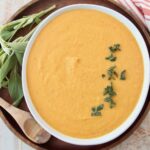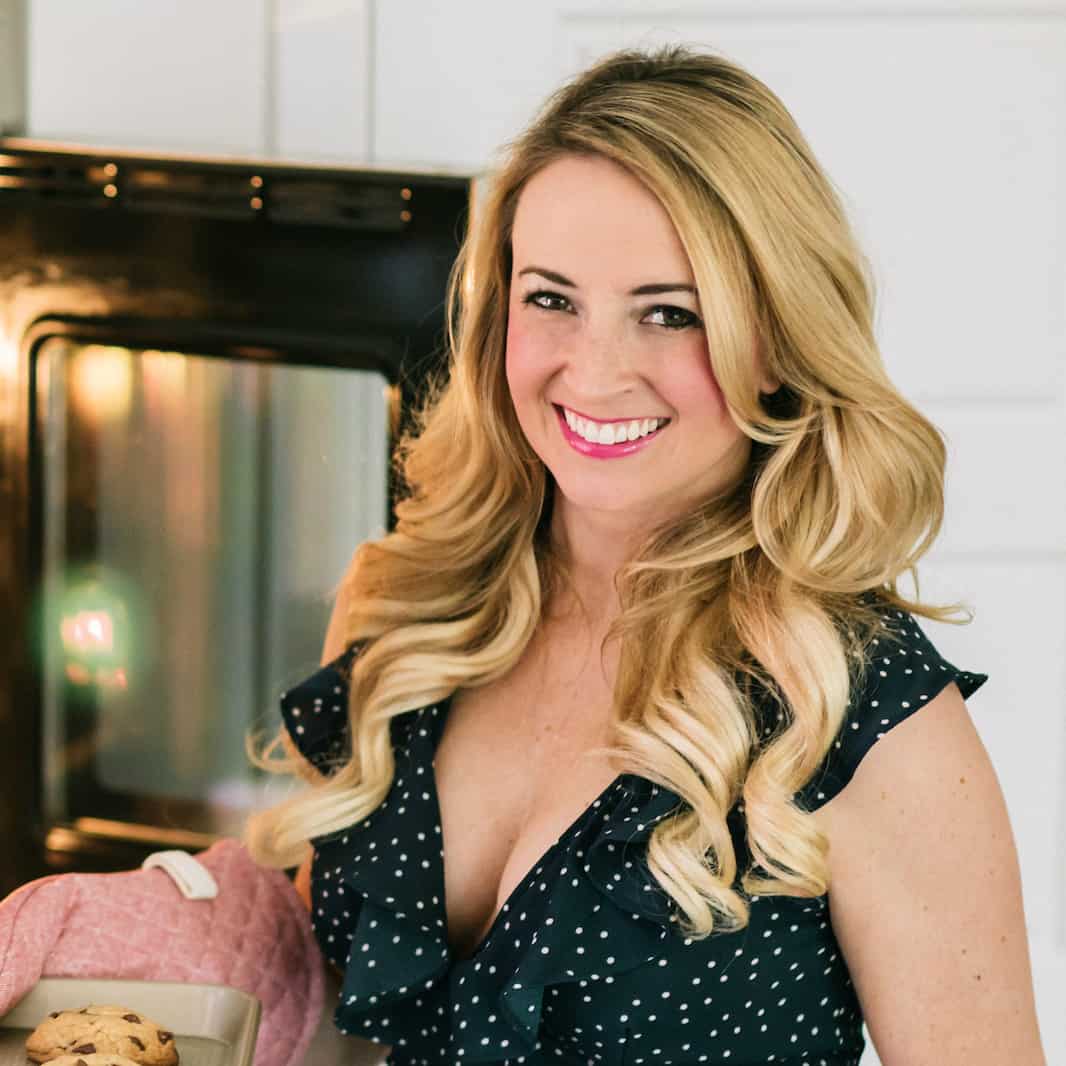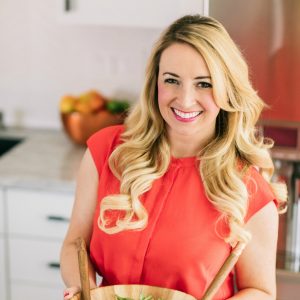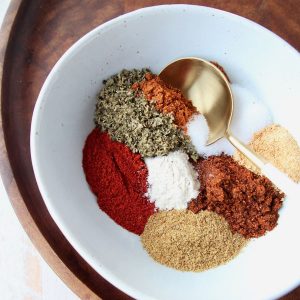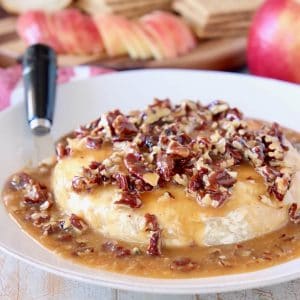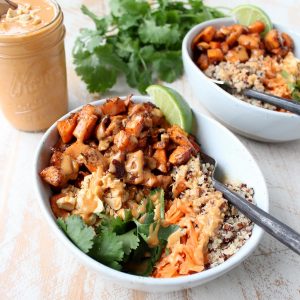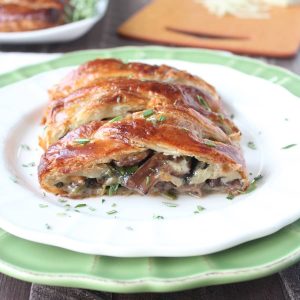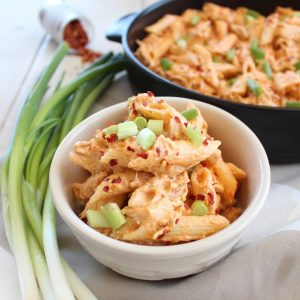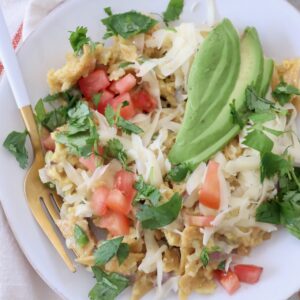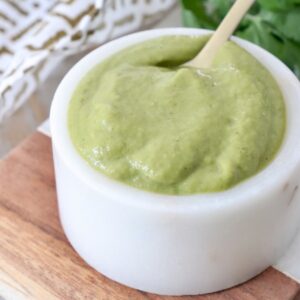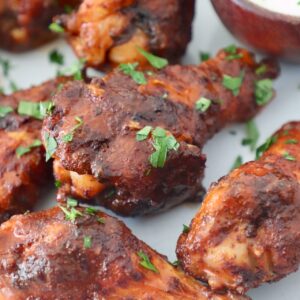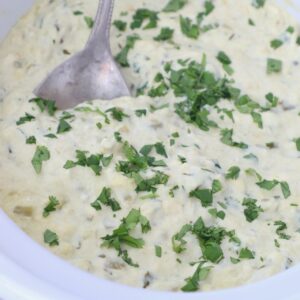Butternut Squash Pasta Sauce
This post may contain affiliate links.
Creamy, vegan butternut squash pasta sauce is so delicious and easy to make in just 30 minutes! Toss it with your favorite pasta and top it with fried sage for a comforting fall meal.
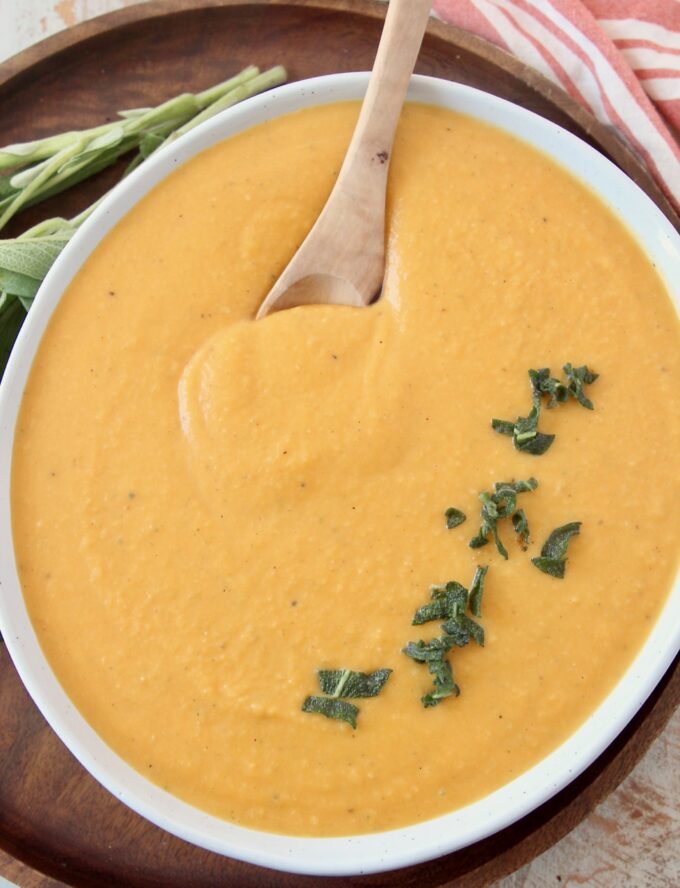
Well hello there creamy goodness! There’s nothing I love more than curling up to the couch on a crisp November evening with a big bowl of spaghetti tossed with butternut squash pasta sauce. It’s fall comfort level 1000!
The best part about this sauce is it’s healthy and easy to make! It’s creamy, with no cream. Thanks to the natural level of creaminess from the butternut squash, plus almond milk, this sauce is vegan and low in calories.
You can even substitute traditional pasta with spaghetti squash or zucchini noodles to make the entire meal healthy and gluten free. Double the squash, double the fun, right?
The other best part of this sauce is just how easy it is to make. After a quick simmer on the stove to tenderize the squash, then a quick blend in a food processor, the sauce is ready to toss with pasta in just 30 minutes!
Make a double batch and store the extra sauce in the refrigerator or freezer for another delicious fall meal. I promise, you’ll be so happy that you did!
Table of contents
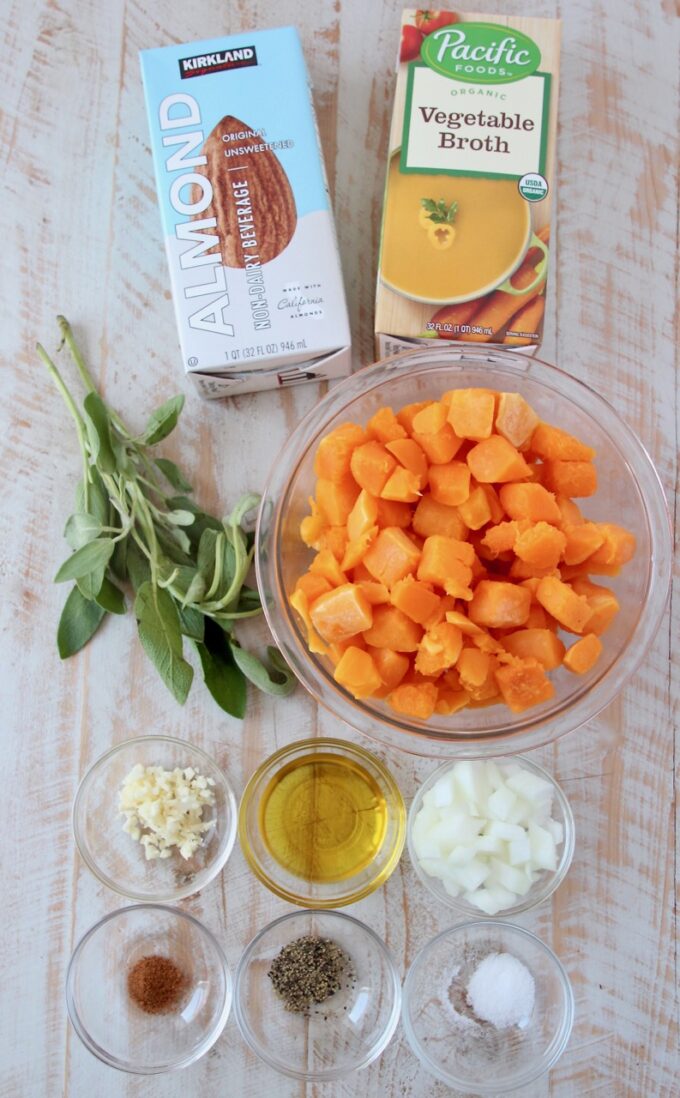
Ingredients
- Olive oil
- Onion
- Garlic cloves
- Butternut squash – feel free to buy a whole butternut squash, peel it, dice it and remove the seeds. Or you can buy already peeled, cubed butternut squash in the produce section at most grocery stores, or frozen on the freezer aisle with the other vegetables.
- Kosher salt
- Black pepper
- Ground nutmeg
- Fresh sage leaves – if you can’t find fresh sage, Litehouse freeze-dried sage is a great alternative!
- Vegetable broth
- Almond milk – you can also use coconut milk in place of the almond milk. Almond milk has a more neutral flavor, where coconut milk has a slightly sweeter flavor.
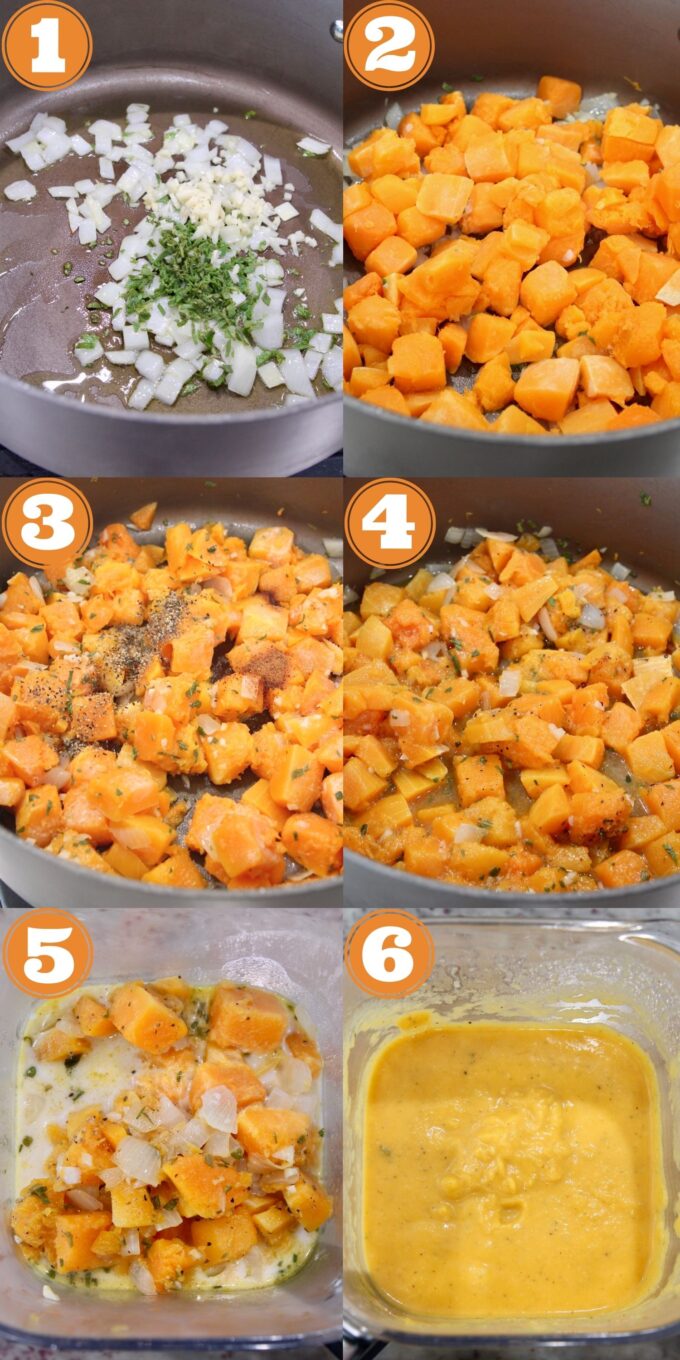
Step by step instructions
- Saute onions, garlic and sage. Heat olive oil in a deep skillet or dutch oven on the stove over medium-high heat. Add the onion and saute for 3-5 minutes. Sprinkle in the garlic and sage. Saute for an additional minute.
- Add the butternut squash to the skillet.
- Season the squash with salt, pepper and ground nutmeg. Cook on the stove for 4-6 minutes.
- Pour the vegetable broth into the skillet. Place a lid on the pan, reduce the heat to low and cook the squash until it’s fork-tender but not falling apart. This will take about 8-10 minutes.
- Transfer the ingredients to a blender or food processor. Once the squash is tender, turn the heat on the stove off and pour all of the ingredients from the skillet into a blender or food processor. Add the almond milk to the blender.
- Blend until smooth. Turn the blender on to high and blend until the sauce is smooth and creamy.
To serve the sauce immediately with pasta, bring a large pot of water to boil on the stove. Add the pasta to the boiling water and cook the pasta according to the package directions. Remove one cup of the cooking water from the pasta before draining it and set the water aside.
Drain the pasta and add it back to the pot, spoon the butternut squash sauce over the pasta and toss it to coat. If you’d like to thin out the sauce, you can gradually add some of the pasta cooking water into the pot with the pasta and sauce. Add 1-2 tablespoons at a time until you reach the desired consistency.
Transfer it to a bowl and add whatever toppings you would like, such as parmesan cheese, candied walnuts or fried sage. You can also toss it with spaghetti squash or use it as pizza sauce. Check out all of the ways you can serve it below.
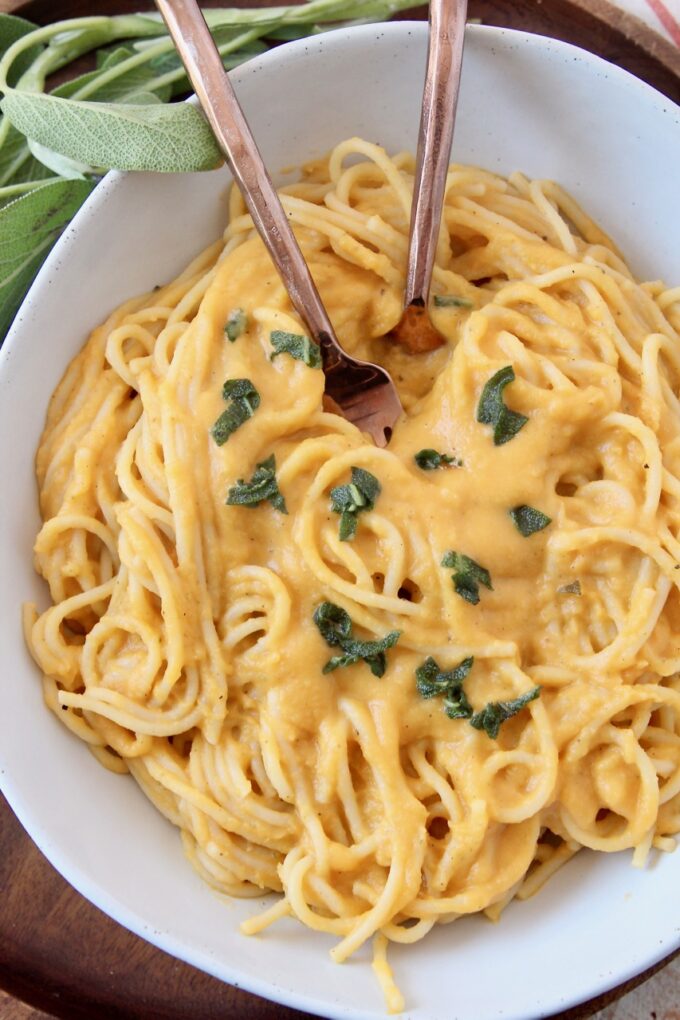
What to serve it with
This pasta sauce is so delicious I could slurp it up with a spoon, like it was soup! But it’s also delicious tossed with pasta, spaghetti squash or added to pizza. Try it served with one of the following options.
- Pasta – since it is a pasta sauce, this one is pretty obvious! But what type of pasta should you serve with it? The possibilities really are endless! It’s great with a long noodle, like spaghetti, fettuccini or pappardelle. But it’s also delicious with a short noodle, like macaroni or cavatappi. You can also pour it over raviolis. For the ultimate fall meal, pair it with this recipe for Sweet Potato Ravioli.
- Fried sage – when serving the sauce with pasta, I like to top it off with fried sage. To make the fried sage, chop 8 fresh sage leaves. Fry them in 1-2 tablespoons of olive oil in a small skillet on the stove over medium-high heat.
- Candied pecans – I also sometimes top the pasta with chopped candied pecans for a little crunch!
- Parmesan cheese – if you’re not vegan, feel free to also sprinkle some fresh-grated parmesan cheese on top.
- Spaghetti squash – for a healthier, gluten free option, and to double up on the squash, pair the butternut squash sauce with roasted spaghetti squash noodles. Refer to this Spaghetti Squash Mac and Cheese recipe for how to roast spaghetti squash.
- Zucchini noodles – for another healthy, gluten free option, toss the sauce with zucchini noodles. You can find pre-made zucchini noodles in the produce section, or freezer section of most grocery stores. Or you can use a spiralizer to make the zoodles at home. Cook the zucchini noodles in a large skillet with olive oil on the stove for 3-5 minutes before tossing with the pasta sauce.
- Pizza – for a festive fall pizza, use Kurt’s Famous Pizza Dough recipe, then top the pizza with this butternut squash sauce instead of tomato sauce. Top the pizza with mozzarella cheese, ricotta cheese, cooked crumbled sage pork sausage and fried sage leaves for a delicious fall-inspired pizza!
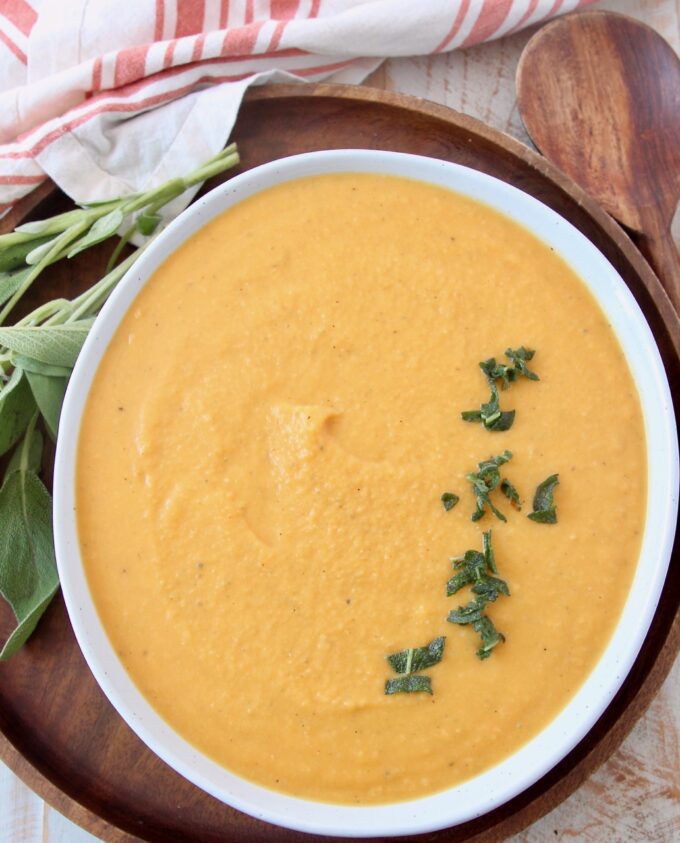
Tips and tricks
- You can make this sauce year-round! While this sauce does gives me all the fall feels, I actually like to make it year-round. Luckily, cubed butternut squash is easily found in the freezer section year-round, so you can make this sauce even when fresh butternut squash is not in season.
- This recipe can be stored in the refrigerator for up to 7 days. Store it in an airtight container such as a mason jar or plastic container with a lid.
- This sauce can also be frozen. You can freeze it in mason jars, just be sure to leave 1 inch of room at the top, for the sauce to expand in the jar. You can also freeze it in a freezer-safe zipper bag or plastic container. The sauce will stay good in the freezer for up to 3 months. I recommend defrosting the sauce in the refrigerator overnight before heating it up to serve.
- To reheat the pasta sauce, add it to a pot on the stove over medium-high heat, stirring frequently for 5-10 minutes, or until heated through. You can also microwave the sauce for 2-3 minutes.
- If you’d like to add a meat to the sauce, I recommend pairing it with a sage pork sausage. Cook and crumble the pork sausage, then toss it with the sauce and pasta.
- To make the sauce spicy, add 1/2 teaspoon red pepper flakes to the sauce with the salt and pepper.
- This sauce recipe is naturally gluten free. Always double check the vegetable broth used, just to make it’s gluten-free. Serve the sauce with gluten-free pasta, zucchini noodles or spaghetti squash to make a gluten free meal.
- This recipe is whole30 approved, when using a whole30 compliant almond milk and vegetable broth.
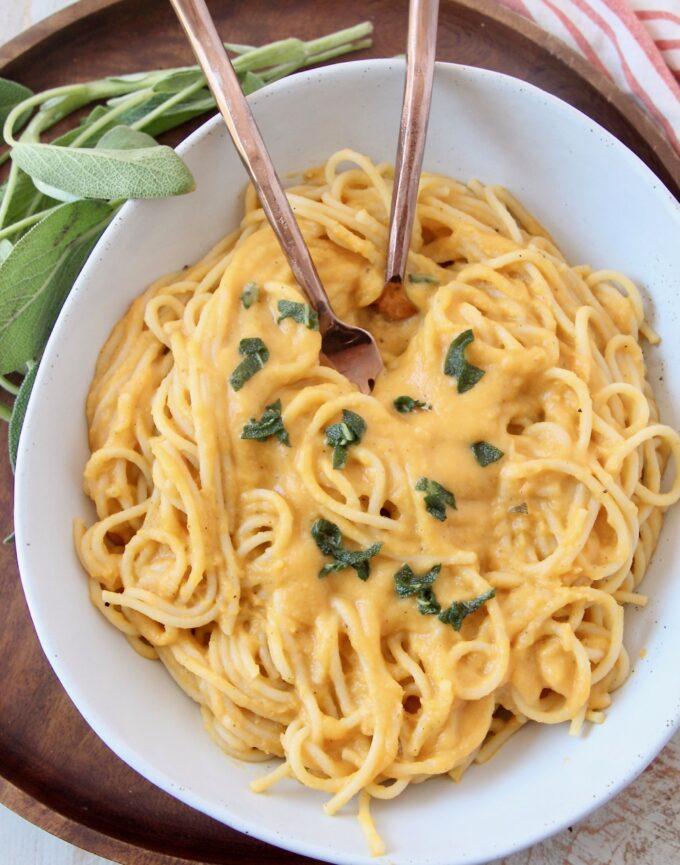
More butternut squash recipes
Add all of these recipes to your must-try fall menu!
- Butternut Squash Apple Bruschetta – THE appetizer of fall!
- Butternut Squash Risotto
- Chai Spiced Butternut Squash Soup
- Butternut Squash Mac and Cheese
- Roasted Butternut Squash Spinach Kale Salad – your new favorite salad recipe!
- Butternut Squash Sausage Strudel
- Sheet Pan Gnocchi with Butternut Squash
Butternut Squash Pasta Sauce
Ingredients
- 2 tablespoons olive oil
- ½ cup yellow onion, diced
- 2 cloves garlic, minced
- 1 tablespoon fresh sage leaves, chopped
- 2 pounds butternut squash, peeled, de-seeded & cubed
- 1 teaspoon kosher salt
- ½ teaspoon black pepper
- ¼ teaspoon ground nutmeg
- 1 cup vegetable broth
- ¾ cup almond milk
Instructions
- Add the olive oil to a deep skillet or dutch oven over medium-high heat.
- Add the diced onion and saute 3-5 minutes.
- Add the minced garlic and fresh chopped sage, saute for an additional minute.
- Add the butternut squash, salt, pepper and nutmeg to the skillet, cook for 4-6 minutes.
- Pour the vegetable broth over the squash.
- Place a lid on the pan, reduce the heat to low and cook the squash until it’s fork tender but not falling apart, about 8-10 minutes.
- Once the squash is tender, transfer all of the ingredients from the pan to a food processor or blender.
- Add the almond milk to the blender.
- Blend until smooth. See the notes below for serving options.
Notes
- To serve the sauce immediately with pasta:
- Bring a large pot of water to boil on the stove.
- Add the pasta to the boiling water and cook the pasta according to the package directions.
- Remove one cup of the cooking water from the pasta before draining it and set the water aside.
- Drain the pasta and add it back to the pot, spoon the butternut squash sauce over the pasta and toss it to coat.
- If you’d like to thin out the sauce, you can gradually add some of the pasta cooking water into the pot with the pasta and sauce.
- Add 1-2 tablespoons at a time until you reach the desired consistency.
- Transfer it to a bowl and add whatever toppings you would like, such as parmesan cheese, candied walnuts or fried sage.
- The pasta sauce is gluten-free and whole30 compliant. Serve it with zucchini noodles or roasted spaghetti squash to make an entirely gluten-free, whole30 approved meal.
- To make this sauce year-round, purchase cubed butternut squash in the freezer section at the grocery store. It should be available even in the spring and summer months.
- This recipe can be stored in the refrigerator for up to 7 days. Store it in an airtight container such as a mason jar or plastic container with a lid.
- This sauce can also be frozen. You can freeze it in mason jars, just be sure to leave 1 inch of room at the top for the sauce to expand in the jar. You can also freeze it in a freezer-safe zipper bag or plastic container. The sauce will stay good in the freezer for up to 3 months. I recommend defrosting the sauce in the refrigerator overnight before heating it up to serve.
- To reheat the pasta sauce, add it to a pot on the stove over medium-high heat, stirring frequently for 5-10 minutes, or until heated through. You can also microwave the sauce for 2-3 minutes.
Nutrition Facts
We are a participant in the Amazon Services LLC Associates Program, an affiliate advertising program designed to provide a means for sites to earn advertising fees by advertising and linking to amazon.com.


